Everything Kids' Magical Science Experiments Book (12 page)
Read Everything Kids' Magical Science Experiments Book Online
Authors: Tim Robinson
Tags: #epub, ebook

See if you can come up with other afterimage drawings and show them to your friends. Experiment with different colors to see how realistic you can make your afterimages look.
Use a blue marker to color all the shapes containing the letters P-U-F-F. As if by magic, you will find the silly answer to this riddle!
Drew was the winner of a five-mile race, but he was a loser at the same time. What did Drew lose?
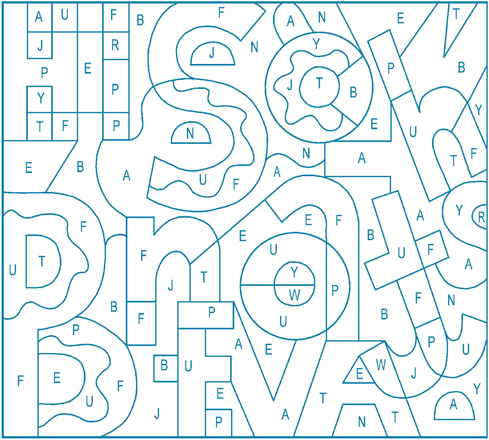
Question: Which antacid works best when you have an upset stomach?
Each time you eat something, your stomach produces acid, which helps your body digest the food. Too much acid can cause indigestion, or an upset stomach. In this experiment, you will test different antacids to see which of them neutralize acid the best. You will use an acid-base indicator, made from red cabbage, to test the success of the antacids.
In your stomach, acid is used to break down the food you eat so that it can be digested and converted to energy for your body. However, sometimes your stomach produces too much acid, and it causes a feeling of discomfort. In addition, that acid can sometimes come up your throat, giving you a burning feeling in your chest commonly known as heartburn. To counteract this acid buildup, people usually take antacids, which are tablets containing ingredients that neutralize the acidity in their stomach. You will be using carbonated soda to simulate the acid in your stomach and will use the red cabbage indicator to test to see how well each antacid works.
KIDS' LAB LESSONS
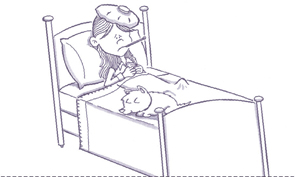
The redder the indicator is, the more acidic the material you are testing. As more of the acid is neutralized, the indicator turns first a bluish, and then a greenish color.
- 1 (2-liter) bottle of carbonated soda
- Several short drinking glasses
- Several brands of antacid, available for purchase in a drugstore
- Baking soda
- Spoon
- Jar of canned red cabbage, available for purchase in a grocery store
- Several small saucers, such as those you would use with coffee cups
- Drain the juice from the jar of red cabbage. This will serve as your acid indicator.
- Pour a small amount of the indicator into each saucer.
- Pour the soda into each of the drinking glasses.
- Gently crumble one tablet of each of the antacids you are testing into the drinking glasses containing carbonated soda.
- Add one spoonful of baking soda to its own glass of soda.
- Use the spoon to stir each antacid into the soda until it is completely dissolved. Rinse the spoon after stirring in each glass.
- Add one spoonful of each soda mixture to its own saucer of acid indicator and stir gently to mix. Be sure to rinse the spoon after each mixture.
- Observe the final color of the acid indicator and determine which antacid was most effective at neutralizing the acid in the soda.
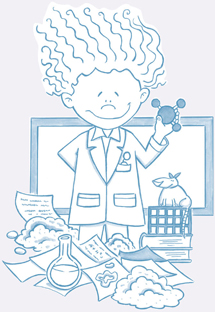
- Which of the antacids was the best at neutralizing the acid in the soda?

- Which foods do you think are most likely to produce heartburn or discomfort in your stomach?

- Are all acids dangerous for you? Research foods that contain acid to see which are healthy and which are not.

Your stomach is an incredible machine. It takes all the food you eat and converts it into the energy you need in order to run, play, laugh, learn, and live. Take care of it and it will last you a lifetime. That means eating well, keeping yourself active, and living a healthy lifestyle.
Question: Can you fool your eyes into thinking they are seeing something that isn't there?
- Your hands
- Small tube
- Stick your index fingers out, facing one another, in front of your face.
- Allow your eyes to relax as you focus your attention on an object far off in the distance.
- Slowly move your fingers toward one another until a small “sausage” appears between them.
Human vision is called
binocular,
which means you see with two eyes. What happens is that each eye actually sees a slightly different picture. The combination of the two viewpoints allows us to tell when something lies in front of or behind something else. It's what allows us to see in three dimensions. In fact, if you were to close one eye and look around, you would only see in two dimensions. It's only by moving your head around, or opening your other eye that you can tell how far away objects are.
Optical illusions are puzzles designed to fool your eyes and brain. These two are classics!
Do you see the white triangle? Look carefully â can you find the lines that make up its edges?
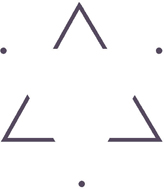
Do you see a flat shape with six sides, or a three dimensional transparent box? Try to go back and forth between the two.
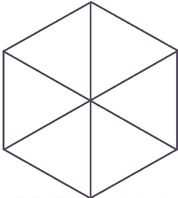
In this experiment, the “sausage” is actually just each of the tips of your fingers, viewed from each eye, overlapping one another. Try the experiment again and notice that outside the “sausage,” you can see images of your fingers. Each one, however, is being seen from different eyes. When those images overlap, it appears to form a small sausage-like shape of your fingers. Your eyes are fooled into thinking they are seeing something they are not actually seeing.
Another fun “trick” to play on your eyes involves holding a small tube in front of one of your eyes. Roll a sheet of computer paper into a tube that is 11 inches long and about ½ inch in diameter. Tape the paper so your tube keeps its shape. With both eyes open, hold the tube up to one eye and look through it. Hold your other hand next to the tube, about two-thirds of the way down the tube. Since one eye will be seeing through the tube to what lies beyond, and the other will be seeing your hand, the two images overlap to make it appear that there is a hole in your hand. This is another example of the effects of binocular vision. See if you can use your binocular vision to come up with new ways to fool your eyes.

BINOCULAR VISION:
Being able to see with both eyes, each from a slightly different angle, which allows you to see in three dimensions.